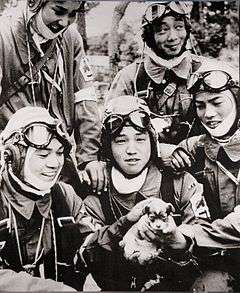Yukio Araki
| Yukio Araki | |
|---|---|
 Portrait of Corporal Yukio Araki. c.1943 | |
| Born |
March 10, 1928 Miyamae-cho, Kiryū, Gunma, Japan |
| Died |
May 27, 1945 (aged 17) USS Braine (DD-630) |
| Allegiance |
|
| Service/ |
|
| Years of service | 1944-1945 |
| Rank | Corporal |
| Unit | 72nd Shinbu Squadron |
| Battles/wars | |
Yukio Araki (Japanese: 荒木 幸雄 Araki Yukio, March 10, 1928 - May 27, 1945) was a Japanese aviator of the Imperial Japanese Army during World War II. As a member of the 72nd Shinbu Squadron, Araki's final mission took place on May 27, 1945 during the Battle of Okinawa when he flew his bomb-laden Mitsubishi Ki-51 to deliberately crash into the USS Braine. It is speculated that Araki and one other pilot are responsible for hitting the ship, killing 66 of its crew. At 17 years old, Araki is one of the youngest kamikaze pilots of World War II.
Biography
Araki Yukio was born on March 10, 1928 on the eastern side of the Watarase River in Miyamae-cho, Kiryu, Gunma Prefecture, Japan. At the age of fifteen he joined the Imperial Japanese Army Air Service's Youth Pilot Training Program.[1] In or around September 1943, he began training at the Tachiarai Air Base. After he graduated he started working at Metabaru Air Field, and in 1944 he got work at Heijo (now known as Pyongyang), in Korea.[2] He became one of the youngest kamikaze pilots during the Second World War when, at the age of seventeen, Araki took off with his outfit, 72nd Shinbu Squadron (第七十二振武隊 Dai 72 Shinbu-tai or 第72振武隊 Dai Nanajūni Shinbu-tai),[3] from Bansei Airfield, at Bansei (now part of Minamisatsuma), Kawanabe District, Kagoshima Prefecture on the Satsuma Peninsula of Kyushu, Japan in a Mitsubishi Ki-51 on 27 May 1945. It has been speculated that his plane was one of two that struck the destroyer USS Braine (DD-630), killing 66 of its crew; however, the ship did not sink.[1][2]
Araki had been home in April 1945, and left letters for his family, to be opened upon the news of his death. The letter to his parents noted:
- Please find pleasure in your desire for my loyalty to the emperor and devotion to parents.
- I have no regrets. I just go forward on my path.[3]
Prior to his mission, and in accordance with the custom of the kamikaze pilots, Araki cut a lock of his hair and clipped his fingernails, which together were to be sent to his parents following his death. These were sent to his family for burial in a cemetery in Kiryu.
Cultural references

In 2004, Tsuneyuki Mori (also spelled Mohri) published Araki's biography, entitled Yuki Died at 17 in a Kamikaze Attack (In Japanese: Yuki wa juunanasai tokkou de shinda). Mori is one of Japan's most noted authors of books about the kamikaze pilots and their world.[4]
See also
References
- 1 2 "Yuki wa juunanasai tokkou de shinda (Yuki died at 17 in a kamikaze attack)". Kamikaze Images. Retrieved 22 March 2016.
- 1 2 Bos, Carole. "Kamikaze Attacks - Pacific Theater, WWII". AwesomeStories.com. Retrieved 22 March 2016.
- 1 2 Gordon, Bill (May 2005). "Last Letters of Corporal Yukio Araki". Kamikaze Images. Retrieved 23 March 2016.
- ↑ Yuki Died at 17 in a Kamikaze Attack from the Kamikaze Images website accessed on June 12, 2016.
External links
- "Who Became Kamikaze Pilots, and How Did They Feel Towards Their Suicide Mission" by Mako Sasaki (1997, 36 pdfs) makes use of Araki's diary and letters
- Yukio Araki (1928-1945) Find a Grave Memorial